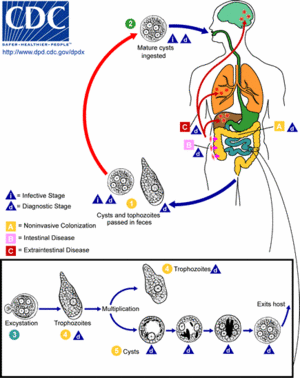Entamoeba histolytica is a single-celled parasite responsible for an infectious disease called amebiasis. So named because of the single-celled organism that causes it, amebiasis is a digestive condition that in severe cases becomes amebic dysentery. According to the National Institutes of Health, 90 percent of people who contract amebiasis experience no symptoms and many people who have entamoeba histolytica never develop the condition at all.
An entamoeba histolytica infection most frequently occurs due to a lack of sanitation or hygiene. The University of Texas at Galveston reports that the parasite can be transmitted by unsanitary food preparation or through dirty water. It lives in human and animal hosts and their fecal matter, and it can survive in water, food, and on surfaces. The primary method of infection is through oral contamination, though the parasite can also be transmitted by genital and anal contact.
The symptoms of an entamoeba histolytica infection are only manifested when amebiasis develops. The Centers for Disease Control report an amebiasis infection rate of less than one out of five people who contract entamoeba histolytica. In those who do develop amebiasis, the condition will generally be manifested within a month of contact with the parasite.
Early symptoms of an entamoeba histolytica infection are generally digestive in nature. The National Institutes of Health report that signs of mild amebiasis include abdominal discomfort, excess gas, and loose stool. In the most severe cases of an entamoeba histolytica infection, amebic dysentery includes symptoms like blood in stool, nausea, vomiting, and a fever.
Rarely, the infection occurs outside of the intestines with the liver being the most frequently affected non-intestinal organ, according to Stanford University. When amebiasis develops in the liver, symptoms can include fever, nausea, and unintentional weight loss, among others. In the rarest cases, amebiasis can develop in the urinary tract, respiratory tract, or the brain.
Stanford University reports a worldwide infection rate of just under one percent with the most frequently affected populations including those located in developing regions where sanitation receives less attention. The NIH reports that the homosexual male population is most frequently affected in the U.S. While very few carriers actually develop amebiasis, it can develop even several months after coming into contact with entamoeba histolytica.
Entamoeba histolytica is a parasite that thrives in unsanitary environments. Though it is most common in less developed countries, anyone can be a carrier without knowing it because it so often presents no symptoms. As is the case with so many infections, simple steps like regular hand-washing and sanitary food preparation are the best and easiest ways to prevent entamoeba histolytica. Any questions about entamoeba histolytica or amebiasis should be directed to an individual’s doctor.
References:
Amebiasis. Division of Parasitic Diseases. Centers for Disease Control.
Amebiasis. National Institutes of Health
Amebiasis. Stanford University.
Entamoeba Histolytica. Medical Microbiology. The University of Texas Medical Branch at Galveston.




